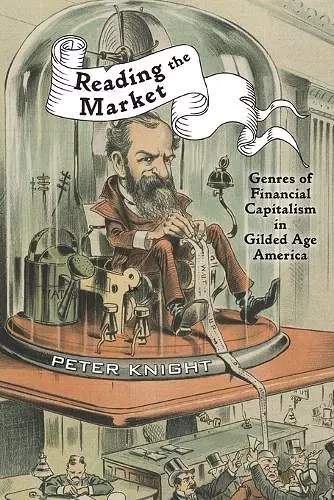Reading the Market
Genres of Financial Capitalism in Gilded Age America
Format:Paperback
Publisher:Johns Hopkins University Press
Published:16th Feb '18
Currently unavailable, and unfortunately no date known when it will be back
This paperback is available in another edition too:
- Hardback£43.00(9781421420608)

America’s fascination with the stock market dates back to the Gilded Age.
Winner of the BAAS Book Prize of the British Association of American Studies
Americans pay famously close attention to “the market,” obsessively watching trends, patterns, and swings and looking for clues in every fluctuation. In Reading the Market, Peter Knight explores the Gilded Age origins and development of this peculiar interest. He tracks the historic shift in market operations from local to national while examining how present-day ideas about the nature of markets are tied to past genres of financial representation.
Drawing on the late nineteenth-century explosion of art, literature, and media, which sought to dramatize the workings of the stock market for a wide audience, Knight shows how ordinary Americans became both emotionally and financially invested in the market. He analyzes popular investment manuals, brokers’ newsletters, newspaper columns, magazine articles, illustrations, and cartoons. He also introduces readers to fiction featuring financial tricksters, which was characterized by themes of personal trust and insider information. The book reveals how the popular culture of the period shaped the very idea of the market as a self-regulating mechanism by making the impersonal abstractions of high finance personal and concrete.
From the rise of ticker-tape technology to the development of conspiracy theories, Reading the Market argues that commentary on the Stock Exchange between 1870 and 1915 changed how Americans understood finance—and explains what our pervasive interest in Wall Street says about us now.
Offers a vivid picture and unique insight and perspective on the significance of the emerging new financial genre and the impact that it was having and would continue to have on the extraordinary American emotional and financial interest in Wall Street and the stock markets. Highly recommended.
—Choice
Reading the Market offers many evidentiary and analytical gems . . . A provocative and well-written study, this book also adds new dimension to our understanding of the literatures and popular culture of American finance. Knight’s model literary analysis should provide ample material for students of American studies and cultural history, and could easily be incorporated into advanced undergraduate and graduate-level coursework.
—H-Net Reviews
This intriguing book illuminates much about markets and, particularly, about the 'culture of the market' as financial capitalism began its will to power in America.
—Civil War Book Review
Knight’s contribution in Reading the Market to the discussion of America’s financial past is powerful and persuasive. His larger work of personalizing its academic genealogy will have a lasting effect on the future scholarly reading of the market’s past.
—Journal of the Gilded Age and Progressive Era
Excellently researched and intricately orchestrated. Reading the Market offers a fresh and original contribution to the history of capitalism, and also to Gilded Age history generally.
—American Historical Review
Curating a rich assemblage of commercial, political, historical, and literary materials, Knight offers a welcome interdisciplinary study that contributes to the social studies of finance, the new history of capitalism, financial print culture, and visual studies in the Gilded Age and Progressive Era.
—Business History Review
Knight . . . ably blend[s] close readings of literary texts with careful examinations of bank records, bond circulars, and other financial arcana, persuasively suggesting that the history of finance cannot be ceded to the conventional realms of economic, social, or cultural analysis . . . Contribute[s] not only to the field of financial history but also to conversations that have long engaged rural and urban historians; scholars of work, labor organizing, and the corporation; and women's and gender historians . . . Lively analysis of an esoteric archive will be of value to students, specialists, and generalists alike.
—Daniel Platt, Brown University, Journal of the Gilded Age and Progressive Era
- Winner of BAAS Book Prize 2017 (UK)
ISBN: 9781421425214
Dimensions: 229mm x 152mm x 21mm
Weight: 454g
336 pages